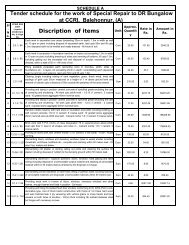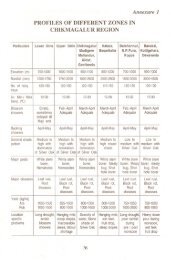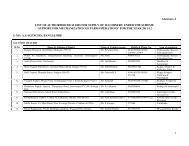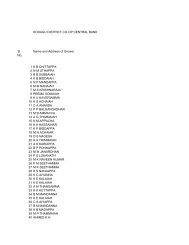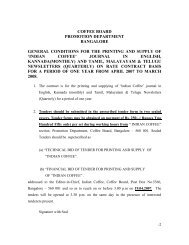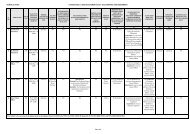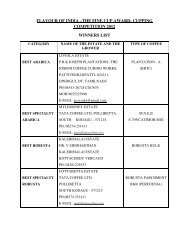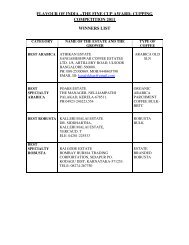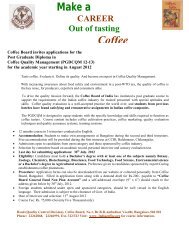COFFEE CULTIVATION GUIDE - Coffee Board of India
COFFEE CULTIVATION GUIDE - Coffee Board of India
COFFEE CULTIVATION GUIDE - Coffee Board of India
You also want an ePaper? Increase the reach of your titles
YUMPU automatically turns print PDFs into web optimized ePapers that Google loves.
The under and over ripe fruits can be converted into cherry c<strong>of</strong>fee. While<br />
harvesting the c<strong>of</strong>fee, picking mats should be used, this helps in easy collection <strong>of</strong><br />
fallen fruits and prevents the mould formation. Prevention <strong>of</strong> mould formation avoids<br />
the production <strong>of</strong> Ochra Toxin-A in c<strong>of</strong>fee beans. Use <strong>of</strong> picking mats also reduces<br />
the <strong>C<strong>of</strong>fee</strong> Berry Borer infection. One should note that, clean gunny bags or plastic<br />
bags should be used for collecting the fruits during harvesting. These bags have to be<br />
regularly washed with clean water, dried and used for collecting the fruits. Bags used<br />
for storing chemicals, fertilizers, pesticides, insecticides and fungicides should never<br />
be used for harvesting c<strong>of</strong>fee fruits. No fruits should be allowed to remain in the<br />
plants after the end <strong>of</strong> season harvest as it can invite berry borer infestation.<br />
3. <strong>C<strong>of</strong>fee</strong> Processing<br />
40<br />
(a): Preparation <strong>of</strong> Robusta Parchment c<strong>of</strong>fee<br />
The pulper, pulper tanks, siphon tanks, rakers, washer, fermentation tanks<br />
should be thoroughly cleaned before the pulping operation is undertaken. The<br />
premises <strong>of</strong> the pulper unit as well as the drying yards should be kept in hygienic way.<br />
The pulper unit should be properly adjusted depending on the fruit size and checked<br />
every day to prevent cuts. Pulper nipped and other deformed beans will yield<br />
defective low quality parchment. All the floats, leaves, twigs should be separated<br />
from the fruits and only ripen fruits should be fed into the pulper using regulated<br />
amount <strong>of</strong> clean water.<br />
Parchment c<strong>of</strong>fee or plantation c<strong>of</strong>fee can be prepared by pulping, cleanly<br />
washed with water and dried under sun. Preparation <strong>of</strong> such c<strong>of</strong>fee requires pulping<br />
equipments and adequate supply <strong>of</strong> clean water. The quality <strong>of</strong> parchment c<strong>of</strong>fee is<br />
always superior to that <strong>of</strong> cherry c<strong>of</strong>fee (whole fruit dried under sun). Cherry c<strong>of</strong>fees<br />
always give fruity taste as the beans are in contact with the mucilage for a longer time<br />
during the course <strong>of</strong> drying period. Therefore, wet processing <strong>of</strong> c<strong>of</strong>fee is essential to<br />
get superior quality c<strong>of</strong>fee and the method can be followed wherever, all the adequate<br />
facilities like sufficient clean water and good processing machineries are available.<br />
The pulping and washing machineries and other equipments used in the<br />
preparation <strong>of</strong> parchment c<strong>of</strong>fee should be cleaned on daily basis. No fruits, fruit<br />
skins or beans from the previous day’s harvest should be allowed to remain and mix<br />
with fresh c<strong>of</strong>fee fruits or pulped beans. These materials badly damage the parchment<br />
c<strong>of</strong>fee quality. Only clean water shall be used for processing c<strong>of</strong>fee fruits and all the<br />
extraneous matters such as leaves, twigs and stones should be thoroughly removed<br />
from the fruits before pulping. If adequate supply <strong>of</strong> water is not available, then the<br />
water used for pulping the fruits can be recycled to pulp the fruits second time. The<br />
pulped water however, should not be used on the second day. Further, pulped water<br />
should never be used for washing the c<strong>of</strong>fee beans under any circumstances.<br />
As far as possible, harvested fruits have to be pulped on the same day <strong>of</strong> the<br />
harvest. If, it is not possible to process all the fruits on the same day, such fruits can<br />
be stored under clean water and pulped on the second day. The fruits stored for more<br />
than 10 hours in the open heap without pulping will result in fruity cup. The fruit<br />
skins separated by pulping should be taken away from the pulping site as quickly as<br />
possible so that microbial decomposition <strong>of</strong> the skin does not affect the quality <strong>of</strong><br />
parchment c<strong>of</strong>fee.<br />
The sticky mucilage on the pulped beans can be removed by 4 different<br />
methods. However, the commonly followed/adopted methods are two namely: (1)<br />
Natural Fermentation and (ii) : Aqua machine wash by friction.<br />
40



